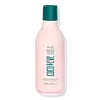What's inside
What's inside
 Key Ingredients
Key Ingredients

 Benefits
Benefits

 Concerns
Concerns

 Ingredients Side-by-side
Ingredients Side-by-side

Water
Skin ConditioningSodium C14-16 Olefin Sulfonate
CleansingSodium Methyl Cocoyl Taurate
CleansingCetyl Betaine
CleansingSodium Cocoamphoacetate
CleansingLauryl Glucoside
CleansingGlycerin
HumectantCocos Nucifera Oil
MaskingAnanas Sativus Fruit Extract
Skin ConditioningNephelium Lappaceum Branch/Fruit/Leaf Extract
Skin ConditioningHydrolyzed Hyaluronic Acid
HumectantArgania Spinosa Kernel Oil
EmollientFicus Carica Fruit Extract
HumectantPersea Gratissima Oil
Skin ConditioningHydrolyzed Pea Protein
EmollientSapindus Trifoliatus Fruit Extract
Skin ConditioningSodium Hyaluronate
HumectantCocos Nucifera Fruit Juice
EmollientCocos Nucifera Water
MaskingPsidium Guajava Fruit Extract
AstringentPhospholipids
Skin ConditioningGlycol Distearate
EmollientPolyquaternium-22
Sodium Cocoyl Glutamate
CleansingSodium Lauryl Glucose Carboxylate
CleansingSodium Stearoyl Lactylate
EmulsifyingGlyceryl Caprylate
EmollientGlyceryl Stearate
EmollientPropanediol
SolventCetearyl Alcohol
EmollientTetrasodium Glutamate Diacetate
Glyceryl Undecylenate
EmollientPolyglyceryl-10 Dioleate
EmulsifyingPolyglyceryl-10 Oleate
Skin ConditioningGuar Hydroxypropyltrimonium Chloride
Skin ConditioningCocamidopropyl Betaine
CleansingLaureth-4
EmulsifyingAcrylates/C10-30 Alkyl Acrylate Crosspolymer
Emulsion StabilisingSodium Benzoate
MaskingPotassium Sorbate
PreservativeParfum
MaskingBenzyl Salicylate
PerfumingCoumarin
PerfumingLinalool
PerfumingCitric Acid
BufferingWater, Sodium C14-16 Olefin Sulfonate, Sodium Methyl Cocoyl Taurate, Cetyl Betaine, Sodium Cocoamphoacetate, Lauryl Glucoside, Glycerin, Cocos Nucifera Oil, Ananas Sativus Fruit Extract, Nephelium Lappaceum Branch/Fruit/Leaf Extract, Hydrolyzed Hyaluronic Acid, Argania Spinosa Kernel Oil, Ficus Carica Fruit Extract, Persea Gratissima Oil, Hydrolyzed Pea Protein, Sapindus Trifoliatus Fruit Extract, Sodium Hyaluronate, Cocos Nucifera Fruit Juice, Cocos Nucifera Water, Psidium Guajava Fruit Extract, Phospholipids, Glycol Distearate, Polyquaternium-22, Sodium Cocoyl Glutamate, Sodium Lauryl Glucose Carboxylate, Sodium Stearoyl Lactylate, Glyceryl Caprylate, Glyceryl Stearate, Propanediol, Cetearyl Alcohol, Tetrasodium Glutamate Diacetate, Glyceryl Undecylenate, Polyglyceryl-10 Dioleate, Polyglyceryl-10 Oleate, Guar Hydroxypropyltrimonium Chloride, Cocamidopropyl Betaine, Laureth-4, Acrylates/C10-30 Alkyl Acrylate Crosspolymer, Sodium Benzoate, Potassium Sorbate, Parfum, Benzyl Salicylate, Coumarin, Linalool, Citric Acid
Water
Skin ConditioningMangifera Indica Fruit Extract
Skin ConditioningPassiflora Incarnata Fruit Extract
Skin ConditioningCamellia Sinensis Leaf Extract
AntimicrobialSodium Cocoyl Isethionate
CleansingCoco-Betaine
CleansingSodium Methyl Cocoyl Taurate
CleansingSodium Cocoyl Glutamate
CleansingDisodium Cocoyl Glutamate
CleansingSodium Chloride
MaskingGlycerin
HumectantOenocarpus Bataua Seed Oil
EmollientPlukenetia Volubilis Seed Oil
EmollientSucrose
HumectantCocoyl Hydrolyzed Quinoa Protein
Mauritia Flexuosa Fruit Oil
Skin ConditioningKaolin
AbrasiveAroma
Cymbopogon Nardus Oil
MaskingLactic Acid
BufferingHydroxyethylcellulose
Emulsion StabilisingGlycine
BufferingCoco-Caprylate
EmollientXanthan Gum
EmulsifyingArginine
MaskingPotassium Sorbate
PreservativeGuar Hydroxypropyltrimonium Chloride
Skin ConditioningWater, Mangifera Indica Fruit Extract, Passiflora Incarnata Fruit Extract, Camellia Sinensis Leaf Extract, Sodium Cocoyl Isethionate, Coco-Betaine, Sodium Methyl Cocoyl Taurate, Sodium Cocoyl Glutamate, Disodium Cocoyl Glutamate, Sodium Chloride, Glycerin, Oenocarpus Bataua Seed Oil, Plukenetia Volubilis Seed Oil, Sucrose, Cocoyl Hydrolyzed Quinoa Protein, Mauritia Flexuosa Fruit Oil, Kaolin, Aroma, Cymbopogon Nardus Oil, Lactic Acid, Hydroxyethylcellulose, Glycine, Coco-Caprylate, Xanthan Gum, Arginine, Potassium Sorbate, Guar Hydroxypropyltrimonium Chloride
 Reviews
Reviews

Ingredients Explained
These ingredients are found in both products.
Ingredients higher up in an ingredient list are typically present in a larger amount.
Glycerin is already naturally found in your skin. It helps moisturize and protect your skin.
A study from 2016 found glycerin to be more effective as a humectant than AHAs and hyaluronic acid.
As a humectant, it helps the skin stay hydrated by pulling moisture to your skin. The low molecular weight of glycerin allows it to pull moisture into the deeper layers of your skin.
Hydrated skin improves your skin barrier; Your skin barrier helps protect against irritants and bacteria.
Glycerin has also been found to have antimicrobial and antiviral properties. Due to these properties, glycerin is often used in wound and burn treatments.
In cosmetics, glycerin is usually derived from plants such as soybean or palm. However, it can also be sourced from animals, such as tallow or animal fat.
This ingredient is organic, colorless, odorless, and non-toxic.
Glycerin is the name for this ingredient in American English. British English uses Glycerol/Glycerine.
Learn more about GlycerinThis ingredient is derived from guar gum.
It is a conditioning ingredient, meaning it helps soften skin and hair.
Potassium Sorbate is a preservative used to prevent yeast and mold in products. It is commonly found in both cosmetic and food products.
This ingredient comes from potassium salt derived from sorbic acid. Sorbic acid is a natural antibiotic and effective against fungus.
Both potassium sorbate and sorbic acid can be found in baked goods, cheeses, dried meats, dried fruit, ice cream, pickles, wine, yogurt, and more.
You'll often find this ingredient used with other preservatives.
Learn more about Potassium SorbateSodium Cocoyl Glutamate is a gentle cleanser and surfactant. It is the sodium salt of the Cocoyl Glutamic Acid and comes from coconut oil. As a surfactant, it helps lift dirt and oil to be washed away.
Sodium Cocoyl Glutamate also has an emolliating effect and can help leave the skin feeling soft.
This gentle cleansing and foaming ingredient is known for leaving a smooth feeling in skin and hair. It is made using coconut oil.
According to the manufacturer, it is soluble in water and has resistance to hard water, acid, and alkali.
Due to its coconut base, it may not be Malassezia folliculitis safe.
Learn more about Sodium Methyl Cocoyl TaurateWater. It's the most common cosmetic ingredient of all. You'll usually see it at the top of ingredient lists, meaning that it makes up the largest part of the product.
So why is it so popular? Water most often acts as a solvent - this means that it helps dissolve other ingredients into the formulation.
You'll also recognize water as that liquid we all need to stay alive. If you see this, drink a glass of water. Stay hydrated!
Learn more about Water